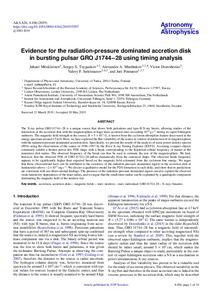Evidence for the radiation-pressure dominated accretion disk in bursting pulsar GRO J1744-28 using timing analysis
Mushtukov AA; Monkkonen J; Poutanen J; Tsygankov SS; Doroshenko V; Suleimanov VF
Evidence for the radiation-pressure dominated accretion disk in bursting pulsar GRO J1744-28 using timing analysis
Mushtukov AA
Monkkonen J
Poutanen J
Tsygankov SS
Doroshenko V
Suleimanov VF
EDP SCIENCES S A
Julkaisun pysyvä osoite on:
https://urn.fi/URN:NBN:fi-fe2021042821480
https://urn.fi/URN:NBN:fi-fe2021042821480
Tiivistelmä
The X-ray pulsar GRO J1744-28 is a unique source that shows both pulsations and type-II X-ray bursts, allowing studies of the interaction of the accretion disk with the magnetosphere at huge mass-accretion rates exceeding 10(19) g s(-1) during its super-Eddington outbursts. The magnetic field strength in the source, B approximate to 5 x 10(11) G, is known from the cyclotron absorption feature discovered in the energy spectrum around 4.5 keV. Here, we have explored the flux variability of the source in context of interaction of its magnetosphere with the radiation-pressure dominated accretion disk. Specifically, we present the results of the analysis of noise power density spectra (PDS) using the observations of the source in 1996-1997 by the Rossi X-ray Timing Explorer (RXTE). Accreting compact objects commonly exhibit a broken power-law PDS shape with a break corresponding to the Keplerian orbital frequency of matter at the innermost disk radius. The observed frequency of the break can thus be used to estimate the size of the magnetosphere. We find, however, that the observed PDS of GRO J1744-28 differs dramatically from the canonical shape. The observed break frequency appears to be significantly higher than expected based on the magnetic field estimated from the cyclotron line energy. We argue that these observational facts can be attributed to the existence of the radiation-pressure dominated region in the accretion disk at luminosities above similar to 2 x10(37) erg s(-1). We discuss a qualitative model for the PDS formation in such disks, and show that its predictions are consistent with our observational findings. The presence of the radiation-pressure dominated region can also explain the observed weak luminosity dependence of the inner radius, and we argue that the small inner radius can be explained by a quadrupole component dominating the magnetic field of the neutron star.
Kokoelmat
- Rinnakkaistallenteet [19218]
